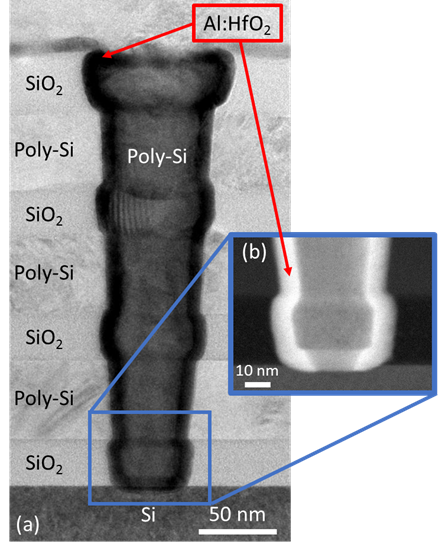Drexel University has been developing Bi-Fe-O ferroelecttrics (and others) for many years and here they report on ALD of polycrystalline BiFeO3 thin films on SiO2/Si(001) by ALD using ferrocene, triphenyl-bismuth, and ozone. Due to its ferroelectric properties BiFeO3 is intersting for future non-volatile memory (FeFETs and FRAM). The ALD of Bi-Fe-O thin films were carried out in a Picosun R200 Advanced Reactor (Supporting Information, for all the process details).
Formation of BiFeO3 from a binary oxide superlattice by #AtomicLayerDeposition @DrexelUniv @DrexelNews https://t.co/UXPTAow8Dn pic.twitter.com/qIvc0F02MD— ChemPhysChem (@ChemPhysChem) June 20, 2017
However, iron is not likely to be used in a standard 300mm CMOS fab today, neither in front nor in backend of line - it´s just diffusing to fast to places it is not wanted. But that said, a stand alone memory technology in a dedicated fab may find ways to handle that. The other contender for novel highly scaled ferroelectric metal oxides is the HfO2 based systems researched by NaMLab, Fraunhofer and GloFo in Dresden Germany. Those systems looks much more promising since they are already shuffling leading edge 300 mm wafers since a while now and HfO2 has been in HVM since 2004 (Samsung 90 nm DRAM, HfAlOx MIS stack). The HfO2 ferroelectric R&D has been going on for more than 10 years actually. This just show s how long time materials and device development takes in the semiconductor industry
Formation of BiFeO3 from a Binary Oxide Superlattice Grown by Atomic Layer Deposition
ChemPhysChemEarly View, Version of Record online: 20 JUN 2017
Abstract: By growing alternating layers of Fe2O3 and Bi2O3, we employ a superlattice approach and demonstrate an efficient control of the cation stoichiometry. The superlattice decay and the resulting formation of polycrystalline BiFeO3 films are studied by in situ X-ray diffraction, in situ X-ray photoelectron spectroscopy, and transmission electron microscopy. No intermediate ternary phases are formed and BiFeO3 crystallization is initiated in the Bi2O3 layers at 450 °C following the diffusion-driven intermixing of the cations. Our study of the BiFeO3 formation provides an insight into the complex interplay between microstructural evolution, grain growth, and bismuth oxide evaporation, with implications for optimization of ferroelectric properties.



%20(1).png)
















